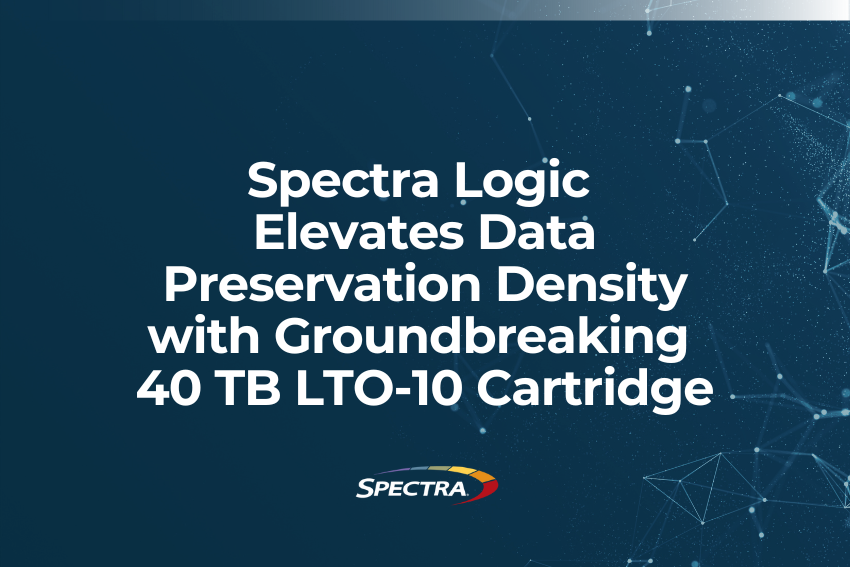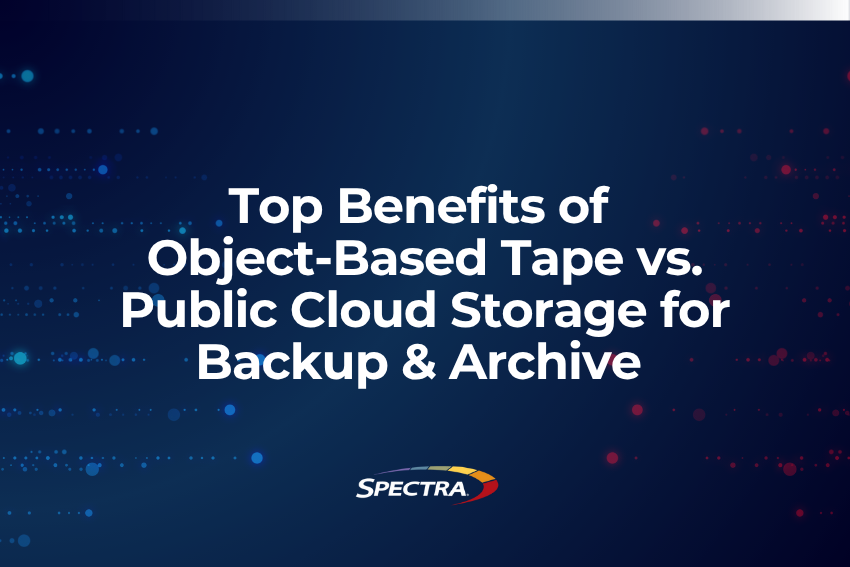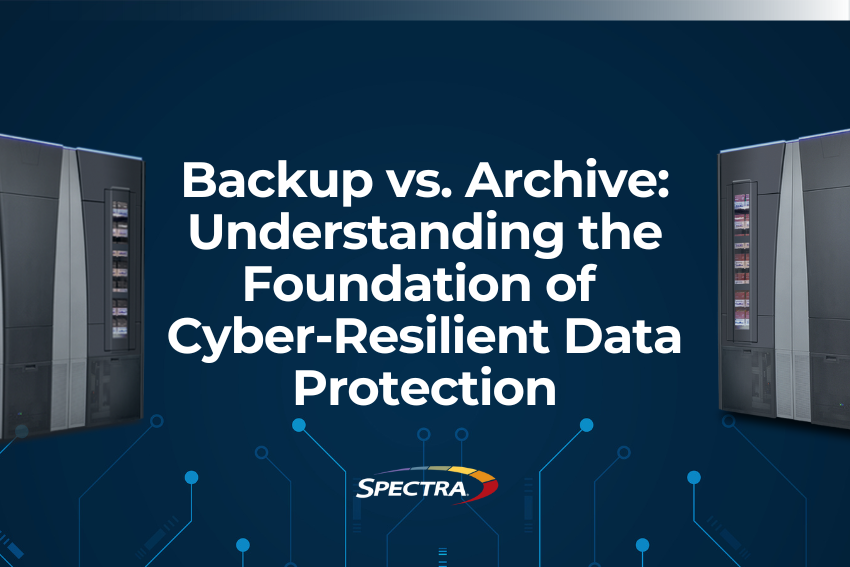
By Jenna Blumenfeld,
Contributor
Here’s how three recent adopters of LumOS are reducing overhead costs, streamlining workflows, and more.
Tape storage is lauded for its energy efficiency, cost effectiveness, unparalleled protection from cybercrime, and ability to safeguard the most valuable data in perpetuity.
Now, we can add speed, simplicity, and technological advancement to the list of tape’s benefits.
Spectra Logic® recently introduced LumOS, a sophisticated operating system created to enhance the usability of tape libraries. Intuitively designed to manage, monitor, and control Spectra tape libraries, LumOS software extends the longevity of data storage investments such as the Spectra TFinity, Spectra Cube, and the T950 for decades into the future.
From automations to multi-threaded operations to AES-256 encryption — a best-practice standard for securing sensitive information — LumOS is packed with enhanced features to boost library functionality.
But in practice, how does LumOS meaningfully improve workflows at some of the world’s most respected institutions? How does it make the job of storing the most important scientific discoveries easier?
Here, three high-performance computing adopters of LumOS from around the globe share their experiences with the software — and why upgrading was worth it.
LumOS Improves Efficiency at Australia’s Pawsey Supercomputing Research Centre
At a Glance:
- The Pawsey Supercomputing Research Centre upgraded to LumOS to improve tape library speed and manage growing expenditures.
- LumOS is three to four times faster than its previous operating system.
In a sleek, purpose-built facility in Kensington, Western Australia, the Pawsey Supercomputing Research Centre hums quietly beneath the weight of some of the most ambitious scientific work in the Southern Hemisphere. Behind its glass, concrete, and photovoltaic walls, Australia’s most powerful research computer facilitates discovery across wide-ranging fields such as radio astronomy and ion-atom collision physics.
To make all this possible, the Pawsey Centre requires more than just raw processing power. It also needs a commitment to progress and a whole lot of tape storage infrastructure.
Chris Schlipalius is the keeper of Pawsey’s massive data storage system, which is named “Banksia” after a resilient native Australian wildflower. As storage manager for supercomputing platforms, Schlipalius and his team ensure data is accessible to scientists worldwide.
Since 2012, the Centre has relied on two 12-frame Spectra Logic TFinity tape libraries to store offline information. With combined capacity that can reach up to 397.8 petabytes, the system is a verifiable digital vault for some of the world’s most important research.
As data demands evolve over time, Schlipalius has stayed focused on adopting innovative solutions designed to streamline workflows.
When Spectra Logic released the LumOS upgrade in 2024, Schlipalius saw an opportunity to improve how the Pawsey Supercomputing Research Centre manages storage costs and ever-expanding data volume. He made the upgrade.
LumOS performs three to four times faster than its previous system — a giant leap forward in responsiveness and performance. Tape library tasks that once required manual interventions are now faster, automated, and more intuitive thanks to LumOS features such as multi-threaded operations, heightened communication with robotics, and flexible control from anywhere, be it local, remote, or programmatic.
The result? Significant time savings for his system administrator.
“LumOS is paying back its expenditure in terms of reduced staff load,” says Schlipalius, underscoring the importance of efficiency and affordability in a government-funded institution where every dollar — and every minute — counts.
Streamlined Technology Propels Scientific Research Forward
At Pawsey, innovation isn’t just about new discoveries.
It’s also about removing friction from the systems that support major scientific milestones. For Schlipalius, that means:
- Faster tape library ticket resolution
- More reliable diagnostics
- Fewer parts to manage.
In turn, this leads to a smoother, consistent flow of research data for institutions across Australia and beyond.
In an era where technological advancement is often paired with complexity, LumOS offers elegant simplicity. It amplifies what Schlipalius and his team do best: enabling the minds behind the data to keep pushing the boundaries of our collective knowledge.
“Spectra Logic tape libraries and technologies simply do what they say,” says Schlipalius. “The future looks bright for LumOS.”
LumOS Modernizes Data Management at France’s CC-IN2P3
At a Glance:
- CC-IN2P3’s mass storage system manager, Pierre-Emmanuel Brinette, upgraded to LumOS to modernize tape library infrastructure and improve speed.
- The LumOS REST API allows Brinette to automate tasks and gain visibility into his tape library metrics.
- LumOS helps CC-IN2P3 manage data from some of the world’s most exciting scientific experiments, including from CERN’s Large Hadron Collider.

Founded in 1971, France’s National Institute of Nuclear and Particle Physics (CC-IN2P3) has long stood at the nexus of vision and discovery. As a division of the French National Centre for Scientific Research (CNRS), CC-IN2P3’s mission is to advance scientific research in nuclear and particle physics across France and the world.
From unraveling the nature of dark matter to designing new instruments for medical diagnostics, IN2P3 is a key player in humanity’s effort to better understand the universe.
Notably, the institute serves as a Tier 1 computing and storage site for CERN. CC-IN2P3 processes and stores data from the Large Hadron Collider (LHC) — the most powerful particle accelerator ever built and the birthplace of breakthroughs such as the Higgs boson, also known as the God Particle (popularized in Dan Brown’s fictional novel, Angels & Demons).
At the center of CC-IN2P3’s data storage strategy is Pierre-Emmanuel Brinette, the institution’s mass storage system manager.
Brinette is not just a custodian of data. He’s also a forward-thinking systems architect with a responsibility to ensure that high-stakes, high-value scientific information doesn’t just sit safely on tape but also remains accessible, actionable, and secure for generations of researchers to come.
Currently, 60% of IN2P3’s active archive capabilities are dedicated to storing data from the LHC. For this, Brinette relies on two nine-frame Spectra TFinity ExaScale tape libraries that he specifically selected for space-efficient density and the ability to mix both LTO and Enterprise tape drives — a valuable optimization strategy to leverage the best technology now and beyond.
But even for someone with Brinette’s technical fluency, such systems can only go so far without evolution. In 2024, he became one of the first Spectra customers to upgrade to LumOS.
Adopting LumOS was a strategic inflection point for CC-IN2P3.
“LumOS helped CC-IN2P3 modernize the way we manage our tape libraries by improving their speed and usability,” Brinette explains.
The difference is tangible. Previously, pulling logs could take upwards of 20 minutes. With LumOS, the same action takes seconds.
Higher Performance, Improved Automation
The software’s REST API enables Brinette and his team to automate actions such as querying the libraries, integrating monitoring stacks, and collecting metrics. Plus, the remote capabilities have removed the most tedious steps from Brinette’s workflow by eliminating the need for manual USB connections — saving hours of valuable time and boosting operational efficiency.
CC-IN2P3 continues to evolve its infrastructure to meet the growing demands of high-energy physics research. Brinette keeps pace by closely collaborating with the engineers behind the Spectra technology.
“As a customer, I can share my requests and feedback directly with the people who design the libraries and software,” he says. “From my perspective, that’s a great benefit!”
As data volumes from global collaborations continue to expand, CC-IN2P3 stands ready with a future-proofed storage strategy at its core.
LumOS Helps Purdue University Continue Its Legacy of Computational Innovation
At a Glance:
- Purdue University’s Ramon Williamson, senior research solutions engineer at the Rosen Center for Advanced Computing, sought a faster operating system for his TFinity tape library, named Fortress.
- Tasks that used to take 15 to 20 seconds are now instantaneous with LumOS.
- Remote operating functionality allows Williamson to better support the storied legacy of Purdue’s time-honored goal of computational innovation.

The year is 1962.
John Glenn becomes the first American astronaut to orbit Earth.
The Seattle World’s Fair unveils the cordless telephone.
Goldfish Crackers debut in grocery stores for the first time.
And at Purdue University, the catalyst of a revolution begins. The very first Computer Science department in the United States is founded, igniting a spark that will fuel decades of innovation in computing, artificial intelligence, biology, climate research, and more.
Purdue’s rich scientific history is illuminated in bright relief on the aptly named Fortress, an 11-frame Spectra Logic TFinity tape library housed in Purdue University’s Rosen Center for Advanced Computing, located in West Lafayette, Indiana.
LumOS Helps Continue Purdue's Lofty Research Initiatives
Speed. Efficiency. The ability to remotely orchestrate complex operations, such as ejecting dozens of tape cartridges (which, before LumOS, required in-person involvement).
These upgrades directly elevate Williamson’s daily workflow to archive mission-critical data for a Tier 1 research university dedicated to improving lives, strengthening national defense, providing a dependable food supply, and more.
Behind the scenes, Williamson plays a pivotal role in upholding Purdue’s proud tradition of bleeding-edge innovation in computational infrastructure. LumOS is a valuable tool that helps him elevate this mission to new heights.
“With LumOS, I can monitor my tape library in a realistic time scale, enabling me to do more without having to take a trip to my data center,” he says. “LumOS is doing the work for me.”






